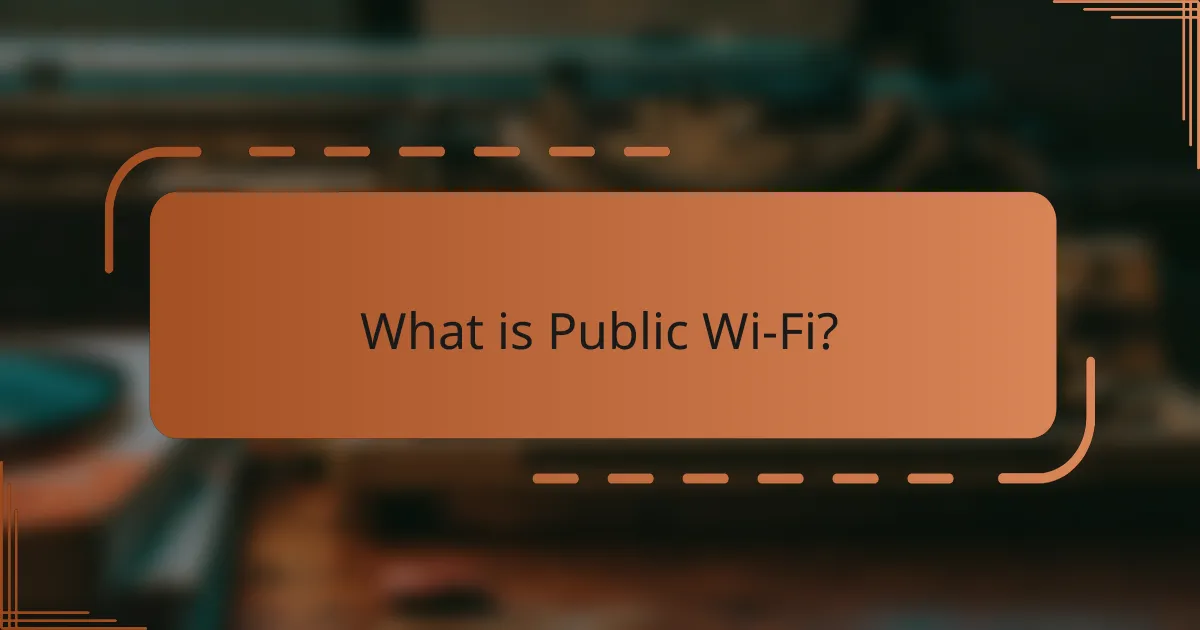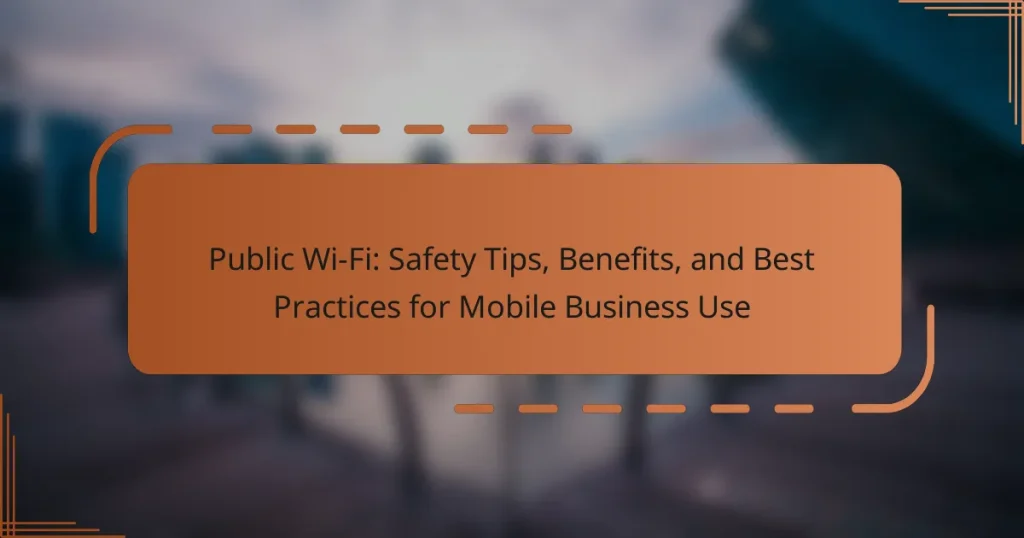Public Wi-Fi refers to wireless networks that provide internet access to the general public, commonly found in locations such as cafes, libraries, airports, and parks. While it offers significant benefits for mobile businesses, including cost-effective connectivity and enhanced productivity, it also presents numerous safety risks. These risks include data interception, man-in-the-middle attacks, rogue hotspots, and malware distribution, with a significant percentage of public networks lacking adequate security measures. This article outlines the safety tips, benefits, and best practices for utilizing public Wi-Fi effectively and securely in mobile business environments.

What is Public Wi-Fi?
Public Wi-Fi is a wireless network that offers internet access to the general public. It is commonly available in places like cafes, libraries, airports, and parks. Users can connect their devices to these networks without needing a password or subscription. Public Wi-Fi networks are typically unsecured, making them vulnerable to cyber threats. According to a study by the Federal Trade Commission, 70% of consumers use public Wi-Fi regularly. This high usage highlights the importance of understanding the risks associated with these networks.
How does Public Wi-Fi work?
Public Wi-Fi works by providing wireless internet access through a network of routers. These routers transmit data over radio waves. Users connect to the network using their devices, such as smartphones or laptops. The device communicates with the router to send and receive data. Public Wi-Fi networks are typically unsecured, allowing multiple users to access the internet simultaneously. This accessibility can lead to potential security risks, such as data interception. According to a report by the Federal Trade Commission, unsecured public Wi-Fi can expose users to hacking and unauthorized access to personal information.
What are the components of a Public Wi-Fi network?
A Public Wi-Fi network consists of several key components. These include access points, routers, and switches. Access points enable devices to connect to the network wirelessly. Routers manage data traffic between the local network and the internet. Switches connect multiple devices within the network, allowing them to communicate.
Additionally, a firewall is often implemented to protect the network from unauthorized access. Network management software helps monitor and maintain the performance of the network. Together, these components create a functioning Public Wi-Fi network that allows users to access the internet.
How is Public Wi-Fi accessed by users?
Public Wi-Fi is accessed by users through their devices’ wireless settings. Users enable Wi-Fi on their smartphones, tablets, or laptops. They then scan for available networks. Once they find a public Wi-Fi network, they select it. Many networks require users to accept terms and conditions. Some may require a password for access. After connecting, users can browse the internet freely. Public Wi-Fi is commonly found in cafes, airports, and libraries.
What are the different types of Public Wi-Fi networks?
There are several types of public Wi-Fi networks. These include municipal Wi-Fi, which is provided by local governments for public use. Commercial Wi-Fi is offered by businesses such as cafes and restaurants to attract customers. Educational institutions often provide campus Wi-Fi for students and staff. Transportation hubs like airports and train stations also feature public Wi-Fi for travelers. Each type serves different purposes and user needs. Municipal Wi-Fi aims to enhance community connectivity. Commercial Wi-Fi focuses on customer convenience. Educational Wi-Fi supports learning environments. Transportation Wi-Fi facilitates travel efficiency.
What distinguishes free and paid Public Wi-Fi services?
Free Public Wi-Fi services are typically offered without any cost to the user, while paid Public Wi-Fi services require a fee for access. Free services often have limitations such as slower speeds, restricted bandwidth, and potential security risks. In contrast, paid services generally provide faster connections, higher reliability, and enhanced security measures. According to a study by the Federal Communications Commission, free Wi-Fi networks are more susceptible to cyber threats due to lack of encryption. Paid services often include customer support and additional features like VPN access.
How do different locations impact Public Wi-Fi quality?
Public Wi-Fi quality varies significantly by location. Urban areas generally offer better Wi-Fi due to higher infrastructure investment. Public spaces like cafes and libraries often provide reliable connections. However, remote locations may have limited bandwidth and connectivity issues. Factors such as user density also affect performance; more users can lead to slower speeds. Additionally, environmental factors like physical obstructions can weaken signals. Research indicates that Wi-Fi access points in densely populated areas experience greater interference. Overall, location directly influences Public Wi-Fi reliability and speed.

What are the safety risks associated with Public Wi-Fi?
Public Wi-Fi poses several safety risks. These risks include data interception, where attackers can capture sensitive information transmitted over unsecured networks. Man-in-the-middle attacks are common, allowing hackers to eavesdrop on communications between users and the network. Additionally, rogue hotspots can mimic legitimate networks, tricking users into connecting and exposing their data. Malware distribution is another risk, as attackers can exploit vulnerabilities in devices connected to public Wi-Fi. According to a 2021 report by the Cybersecurity & Infrastructure Security Agency, over 80% of public Wi-Fi networks lack adequate security measures. This statistic highlights the prevalence of risks associated with using public Wi-Fi.
What common threats should users be aware of?
Common threats users should be aware of when using public Wi-Fi include eavesdropping, man-in-the-middle attacks, and rogue hotspots. Eavesdropping occurs when cybercriminals intercept data transmitted over unsecured networks. Man-in-the-middle attacks involve hackers positioning themselves between the user and the network to capture sensitive information. Rogue hotspots mimic legitimate networks to trick users into connecting and stealing their data. According to a 2020 report by the Cybersecurity & Infrastructure Security Agency, over 80% of public Wi-Fi networks lack encryption, making them vulnerable to these threats. Users should always use a VPN and avoid accessing sensitive information on public networks to mitigate these risks.
How do hackers exploit Public Wi-Fi networks?
Hackers exploit public Wi-Fi networks primarily through techniques like man-in-the-middle attacks. In these attacks, hackers intercept communications between users and the network. They can capture sensitive information such as passwords and credit card numbers. Another method is the creation of rogue hotspots that mimic legitimate networks. Users unknowingly connect to these hotspots, exposing their data. Additionally, hackers can use packet sniffing to analyze data packets transmitted over the network. This allows them to gather unencrypted information. According to a study by the Federal Trade Commission, 70% of public Wi-Fi networks lack proper security measures. This vulnerability makes it easier for hackers to exploit these networks.
What is the role of unsecured networks in data breaches?
Unsecured networks play a significant role in data breaches by providing easy access for cybercriminals. These networks, often found in public spaces, lack encryption and security protocols. This absence allows attackers to intercept data transmitted over the network. According to a study by the Federal Trade Commission, 70% of consumers do not secure their devices when using public Wi-Fi. As a result, sensitive information such as passwords and financial data becomes vulnerable. Cybercriminals can exploit this vulnerability to conduct identity theft or financial fraud. The risk is heightened when users connect automatically to available networks without verifying their security.
How can users protect themselves while using Public Wi-Fi?
Users can protect themselves while using public Wi-Fi by following specific security measures. First, they should use a virtual private network (VPN) to encrypt their internet connection. This makes it difficult for hackers to intercept data. Second, users should avoid accessing sensitive information, such as banking details, while on public networks. Third, enabling two-factor authentication on accounts adds an extra layer of security. Fourth, keeping software and devices updated ensures protection against vulnerabilities. Additionally, users should disable file sharing and use a firewall to block unauthorized access. Lastly, they should forget the network after use to prevent automatic connections in the future. These practices significantly reduce the risk of data breaches and unauthorized access.
What tools and software enhance Public Wi-Fi security?
VPNs (Virtual Private Networks) enhance Public Wi-Fi security by encrypting internet traffic. They create a secure tunnel between the user and the internet, preventing unauthorized access. Firewalls also enhance security by monitoring incoming and outgoing traffic. They block potentially harmful connections and protect devices from attacks. Antivirus software is crucial for detecting and removing malware. It provides real-time protection against threats that may exploit public networks. Password managers enhance security by generating and storing strong passwords. They reduce the risk of password theft on unsecured networks. Security applications like Wi-Fi scanners identify vulnerabilities in public networks. They alert users to potential threats, ensuring safer connections. Together, these tools create a robust defense against risks associated with Public Wi-Fi.
How does using a VPN improve safety on Public Wi-Fi?
Using a VPN improves safety on public Wi-Fi by encrypting internet traffic. This encryption prevents unauthorized access to personal data. Public Wi-Fi networks are often unsecured, making them vulnerable to hackers. A VPN creates a secure tunnel for data, ensuring privacy. According to a 2021 study by the Cybersecurity & Infrastructure Security Agency, 60% of public Wi-Fi users are at risk without a VPN. By masking the user’s IP address, a VPN adds an additional layer of anonymity. This makes it harder for attackers to track online activities. Overall, using a VPN significantly reduces the risks associated with public Wi-Fi.

What are the benefits of using Public Wi-Fi for mobile business?
Public Wi-Fi offers several benefits for mobile businesses. It provides cost-effective internet access in various locations. This allows employees to stay connected without incurring data charges. Public Wi-Fi also enhances productivity by enabling access to cloud services and collaboration tools on the go. It facilitates customer engagement through online services and promotions. Many public Wi-Fi networks are available in high-traffic areas, increasing visibility for mobile businesses. Additionally, it supports remote work flexibility, allowing employees to work from anywhere. Overall, public Wi-Fi is a valuable resource for enhancing operational efficiency in mobile business settings.
How does Public Wi-Fi enhance productivity for mobile workers?
Public Wi-Fi enhances productivity for mobile workers by providing internet access in various locations. This connectivity allows workers to stay connected and complete tasks remotely. According to a study by Cisco, 80% of mobile workers reported increased productivity due to accessible internet. Public Wi-Fi enables seamless communication through emails and messaging apps. It supports cloud-based applications that require internet access for real-time collaboration. Additionally, mobile workers can conduct research and access resources on the go. This flexibility leads to better time management and efficiency. Overall, public Wi-Fi is a crucial tool for enhancing the productivity of mobile workers.
What are the advantages of accessing cloud services via Public Wi-Fi?
Accessing cloud services via Public Wi-Fi offers convenience and flexibility. Users can connect to cloud applications from various locations without needing a personal network. This accessibility supports remote work and enhances productivity. Public Wi-Fi networks are often widely available in cafes, airports, and libraries. This widespread presence allows users to stay connected on the go. Additionally, many cloud services facilitate collaboration among teams, enabling real-time updates and communication. However, users should be cautious about security risks associated with public networks. Employing VPNs and secure connections can mitigate these risks.
How can Public Wi-Fi facilitate communication for remote teams?
Public Wi-Fi can facilitate communication for remote teams by providing accessible internet connectivity. This connectivity allows team members to connect from various locations. Remote workers can use public Wi-Fi to access communication tools. These tools include email, messaging apps, and video conferencing platforms. According to a report by Cisco, over 50% of remote workers rely on public Wi-Fi for work-related tasks. Public Wi-Fi enables collaboration regardless of geographical barriers. It supports real-time updates and information sharing among team members. This connectivity enhances productivity and responsiveness in remote work environments.
What best practices should mobile businesses follow when using Public Wi-Fi?
Mobile businesses should implement several best practices when using Public Wi-Fi. First, they should use a Virtual Private Network (VPN) to encrypt their internet connection. This prevents unauthorized access to sensitive data. Second, they must avoid accessing sensitive information, such as banking details, while connected to public networks. Research shows that 70% of public Wi-Fi networks are not secure. Third, businesses should keep software and security systems updated to protect against vulnerabilities. Regular updates can prevent exploitation of known security flaws. Fourth, they should disable sharing settings on devices to limit exposure to potential threats. Lastly, businesses should connect only to trusted networks and verify the network name before connecting. This minimizes the risk of connecting to rogue hotspots.
How can businesses ensure secure transactions over Public Wi-Fi?
Businesses can ensure secure transactions over Public Wi-Fi by implementing several key practices. First, they should use a Virtual Private Network (VPN) to encrypt data. This prevents unauthorized access to sensitive information. Second, businesses must ensure that their websites use HTTPS. HTTPS encrypts data exchanged between the user and the website. Third, they should avoid accessing sensitive information, such as banking details, on public networks. This reduces the risk of data interception. Additionally, businesses can employ two-factor authentication for added security. This requires a second form of verification beyond just a password. Regular software updates and security patches are also crucial. They protect against vulnerabilities that hackers may exploit. Lastly, educating employees about the risks of public Wi-Fi can help them make informed decisions. These practices collectively enhance transaction security over public Wi-Fi.
What strategies can enhance user experience on Public Wi-Fi?
To enhance user experience on Public Wi-Fi, implementing several strategies is essential. First, ensure a strong and stable connection by selecting networks with high bandwidth. Research shows that users experience frustration with slow connections, impacting productivity. Next, utilize a Virtual Private Network (VPN) to secure data during transmission. According to cybersecurity experts, using a VPN can prevent unauthorized access to sensitive information. Additionally, provide clear instructions for connecting to the Wi-Fi network. Users appreciate straightforward guidelines, which can reduce confusion and enhance satisfaction. Finally, regularly update network hardware and software to improve performance. Studies indicate that outdated systems can lead to connectivity issues, negatively affecting user experience.
What troubleshooting tips can help users effectively utilize Public Wi-Fi?
Ensure your device is connected to the correct Wi-Fi network. Verify the network name matches the public Wi-Fi provider. Restart your device to refresh the network connection. Check if airplane mode is disabled to allow Wi-Fi access. Forget the network and reconnect to resolve potential connection issues. Disable VPNs or proxies that may interfere with the connection. Verify that your device’s software is up to date for optimal performance. If the connection is slow, try moving closer to the router or access point for a stronger signal.
Public Wi-Fi is a wireless network that provides internet access to the general public in locations such as cafes, libraries, and airports. This article explores the workings of public Wi-Fi, its various types, and the safety risks associated with unsecured networks, including data interception and man-in-the-middle attacks. Additionally, it outlines best practices for users and mobile businesses to enhance security and productivity while utilizing public Wi-Fi, emphasizing the importance of tools like VPNs and secure connections. The content also highlights the benefits of public Wi-Fi for mobile businesses, including cost-effective access and improved communication for remote teams.


